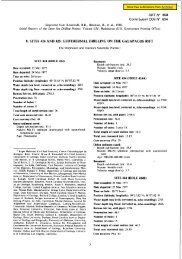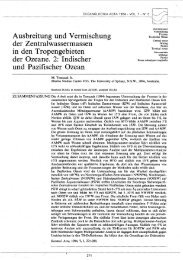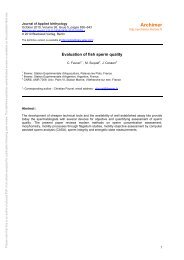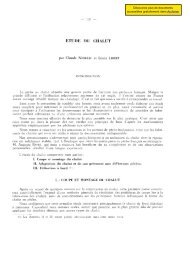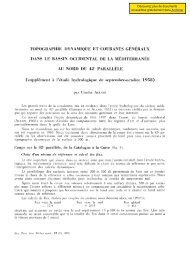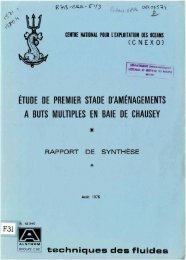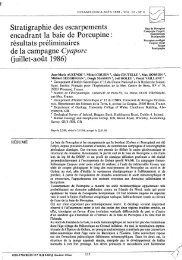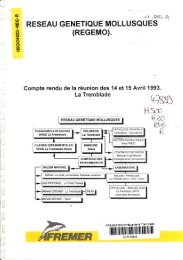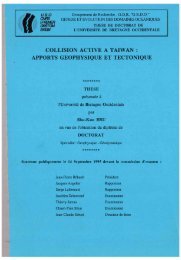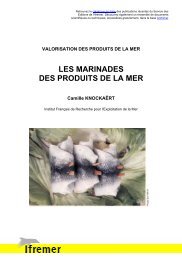Approche quantitative de la fonction de nourricerie jouée par les ...
Approche quantitative de la fonction de nourricerie jouée par les ...
Approche quantitative de la fonction de nourricerie jouée par les ...
Create successful ePaper yourself
Turn your PDF publications into a flip-book with our unique Google optimized e-Paper software.
Chapitre 4 : Impact of vegetation structure dynamics and usage on the nursery function<br />
of West European tidal salt-marshes.<br />
3. Material and methods :<br />
3.1. Description of study sites :<br />
The nature reserves of the Aiguillon bay situated in Ven<strong>de</strong>e (north) and Charentes<br />
Maritime administrative districts (south) on the At<strong>la</strong>ntic coast of France constitute an<br />
ecological area consistent in term of spatial distribution for fish. This area consists of 3700 ha<br />
of bare mud-f<strong>la</strong>ts, of 1100 ha of salt marshes ("mizottes") at the head of the bay, and of 100<br />
ha of tidal creeks (Meunier et Joyeux 2003). The salt marshes are the subject of a<br />
management p<strong>la</strong>n involving mowing to maintain grass<strong>la</strong>nd suitable for Anatidae. The areas<br />
drained by the creeks flowing into the Canal <strong>de</strong> Luçon are therefore mown between May and<br />
July, favouring Puccinellia maritima and Elytrigia atherica communities to the <strong>de</strong>triment of<br />
the original community dominated by Halimione portu<strong>la</strong>coi<strong>de</strong>s that is much more productive<br />
and offers a suitable habitat for amphipods such as Orchestia gammarellus (Pal<strong>la</strong>s 1766). In<br />
addition to management activities, there is a very intensive elver fishery from mid-November<br />
to early March. The winter of 2003-2004 was notable for the <strong>la</strong>rge number of intrusions into<br />
the Canal <strong>de</strong> Luçon, <strong>par</strong>ticu<strong>la</strong>rly by professional fishermen (Meunier pers. comm.). The<br />
sampling sites are situated on either si<strong>de</strong> of the tidal channel of the Sèvre Niortaise River.<br />
The Canal <strong>de</strong> Luçon site (46°18’57N; 01°09’53W) was chosen for its position as a tributary<br />
of the canal (10 m wi<strong>de</strong>). It drains the water of an artificial catchment of 10 ha that is cut for<br />
hay as <strong>par</strong>t of the management p<strong>la</strong>n. The vegetation is dominated by E. atherica. The second<br />
study site is a tributary of the Canal du Curé (46°15’49 N; 01°07’09W) that drains about 10<br />
ha of H. portu<strong>la</strong>coi<strong>de</strong>s salt marshes.<br />
A complementary study consisting of two fishing surveys (at the same time as those<br />
conducted in the Aiguillon bay) was conducted in two sites in the Mont Saint-Michel bay<br />
(48°40’ N, 1°40’ W) already studied for many years (Laffaille et al. 2000a; Parlier 2002;<br />
Laffaille et al. 2005). The two creeks studied were a few hundred metres a<strong>par</strong>t and both<br />
drained an area of salt marshes of about ten hectares. The p<strong>la</strong>nt community had the normal<br />
vegetation succession typical of a salt marsh in one of the sites (Ponton), whereas the other<br />
(Tesnière) had been subject to severe changes in p<strong>la</strong>nt structure as a result of invasion by E.<br />
atherica (see Parlier, 2002).<br />
122



